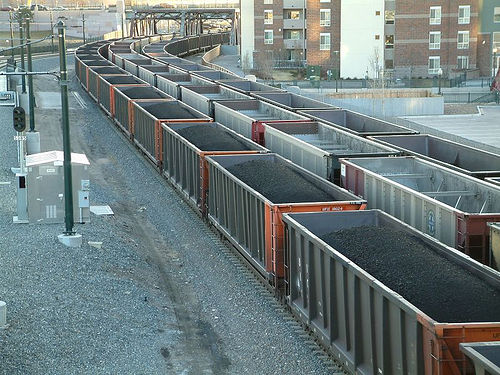
Photo credit Jesse Varner
Whatever you think about coal exports, you’ve got to admit the proponents have a terrific sense of humor. Check out this knee-slapper from a BNSF advocacy group supporting the proposed Northwest terminals:
Opponents like to state that communities and tax payers should not pay for needed rail improvements to handle the increased freight.
The facts: All upgrades to Washington state freight railroad infrastructure are paid for by private capital from the freight railroads, not by taxpayer dollars. [emphasis added]
Hilarious!
I actually burst out laughing when I first read that because it’s so obviously false. As the state’s transportation department points out in a freight mobility report:
WSDOT oversees the expenditure of funds provided by the Legislature for capital rail projects throughout the state and is responsible for administering both the Freight Rail Assistance Program and the Freight Rail Investment Bank Program. The Legislature authorized $5.85 million in the 2007-2009 biennium and $7.75 million in the 2009-2011 biennium for these freight rail grant and loan programs. [emphasis added]
In fact, over at WSDOT’s website, you can take a gander at 21 taxpayer-funded rail upgrades that are underway right now plus 27 more taxpayer-funded rail upgrades that are already complete. Now, in fairness, many of these projects are funded by federal stimulus money to benefit high speed rail, but almost all of them also have clear benefits for the freight rail—because it’s all the same infrastructure. That’s the case, for instance, with the $150 million rail yard improvement in Vancouver.
We know that many of these projects are designed to produce benefits for both passenger and freight rail because the transportation department specifically identifies them in documents with titles like: “Legislative Funding Packages with Medium- or High-Freight Benefits.”
Other examples are more clear cut, such as the Mt Vernon Siding Extension project that will lengthen a siding in order to accommodate freight trains at a cost to taxpayers of $8.5 million, including more than $2.1 million derived from sales tax on vehicle purchases. The stated benefits include items such as, “freight rail safety” and “increased freight rail capacity.” It’s similar to the completed Stanwood siding upgrade paid for by the state vehicle sales tax to benefit freight rail. The same is true of a rail reconfiguration at Centralia that will yield a variety of benefits, including “increased capacity for Burlington Northern,” with $12.8 million in taxpayer funds.
None of this is a secret. In fact, the state transportation department goes out of its way to advertise the public money that it makes available to freight rail. Sometimes the headlines of their news releases start with words like, “State funds available for freight rail projects.”
Washington’s “2010-2030 Freight Rail Plan” goes further, specifically calling out the government’s intention to continue paying for freight rail infrastructure. From the executive summary:
The need for expansion to meet future demand can only be achieved
through involvement of both the public and private sectors. The state, as
well as private rail owners, has invested vigorously in the rail systems in
the recent years……the state will have to pursue federal funding, as well as boost state
spending, and establish public-private partnerships to close the gap
between available resources and freight rail needs.
It’s a pretty open-and-shut case, really.
Now, to be clear, I don’t think there’s anything wrong with public funding for freight mobility. It’s a worthwhile public policy objective. But I have a big problem with patently false statements to the effect that private railroad interests pay full freight. Because, ultimately, it seems to me that if the public is paying for freight rail capacity, then the public should have some say over whether that infrastructure is used for hugely destructive coal export plans.
It’s funny that the coal proponents use arguments like this—not just on one website, but in repeated distributions to local governments and members of the public. I guess we have to assume that they’re just doing it for a few yuks.
Otherwise, it would seem like a bald-faced lie.









Ross Macfarlane
Great post. It is important to point out that these payments are for freight rail “capacity” improvements, where there is usually a mix of public and private expenditures. For improvements needed to help communities and local businesses deal with traffic and safety issues, the public usually pays between 95% and 100% of the cost.
Holly Stamper
The Oregon International Port of Coos Bay owns the railroad from Veneta to Coos Bay. I think that means we the taxpayers are paying for it.